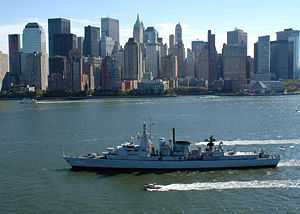Jacob van Heemskerck-class frigate
 Jacob van Heemskerck (F812) in New York, 2004 | |
| Class overview | |
|---|---|
| Name: | Jacob van Heemskerck , L type |
| Builders: | Royal Schelde Shipyard |
| Operators: | Royal Netherlands Navy, Chilean Navy |
| In service: | 1986-present day |
| In commission: | 1986- |
| Completed: | 2 |
| Active: | 2 |
| General characteristics | |
| Type: | frigate |
| Displacement: | 3000 tons standard (3,750 tons full load) |
| Length: | 130 m |
| Beam: | 14.5 m |
| Draught: | 4.4 m |
| Propulsion: | 2 shaft combined gas and gas (COGAG) system
|
| Speed: | 30 knots maximum, 20 knots cruising |
| Range: | 4700 nmi at 16 knots |
| Complement: | 197 |
| Sensors and processing systems: | Radar: LW-08, SMART-S Mk1, 2x STIR-240, STIR-180, ZW-06 Sonar PHS-36 |
| Armament: |
|
The Jacob van Heemskerck class frigate was a class of frigates of the Royal Netherlands Navy. They were built to be an air defence version of the Kortenaer class frigate. The helicopter was replaced by a Standard medium range SAM system and associated radars. 2 ships were built for the Dutch Navy, in 2005 they were sold to the Chilean Navy.
Design
In the early 1970s, the Koninklijke Marine (Royal Netherlands Navy) developed what became known as the 'Standard' frigate, with anti-submarine and anti-aircraft versions using common hull designs and machinery and as far as practicable, common electronics and sensors.[1] It was planned to order 12 anti-submarine variants (the Kortenaer class, enough to equip two task groups (each led by a Tromp-class guided missile frigate) to operate in the Atlantic, while a single anti-aircraft version would act as flagship for a third task group, consisting of the older Van Speijk-class frigates to operate in the English Channel and North Sea.[2] In 1981, however, two Kortenaers were sold to Greece while building, and it was decided to build two anti-aircraft versions of the 'Standard' class (the 'L' class) as replacements, with the planned 13th 'Standard'-class frigate being abandoned.[3][4]
The design's flush-decked hull, with an overall length of 130.20 metres (427.2 ft), a beam of 14.40 metres (47.2 ft) and draught of 4.23 metres (13.9 ft), is the same as used in the Kortenaers, as was the Combined gas and gas (COGAG) machinery, with two Rolls-Royce Tyne RM-1C cruise engines (3,700 kilowatts (4,900 shp)) and two Rolls-Royce Olympus TM-3 boost engines (19,200 kilowatts (25,800 shp)) drive the ship to a speed of 30 knots (35 mph; 56 km/h).[1][4]
A Mk 13 missile launcher for the American Standard SM-1 medium-range surface-to-air missile (SAM) (with a 40-missile magazine) replaced the helicopter hangar and deck of the Kortenaers. This was supplemented by an eight round Mk 29 NATO Sea Sparrow short range SAM launcher forward, with 24 missiles carried. A Goalkeeper close-in weapon system was mounted aft, while the forward-mounted OTO Melara 76 mm gun of the Kortenaers was omitted. Launchers for eight Harpoon anti-ship missiles were positioned amidships, while anti-submarine armament consisted of four tubes for Mark 46 torpedos.[4]
As built, the ships were fitted with a Signaal LW-08 long-range air search radar, a DA-05 target tracking radar. Two STIR-240 director radars provided guidance for the Standard missiles, while a STIR-180 radar directed the Sea Sparrow missiles. A PHS-36 hull sonar was also fitted.[5]
Ships
Two ships were built by Royal Schelde dockyard. The ships were named after Admirals as is usual practice in the Royal Netherlands Navy.
- F812 Jacob van Heemskerck,
- named after Jacob van Heemskerk,
- laid down 21 January 1981,
- launched 5 November 1983,
- completed 15 January 1986.
- Sold to Chile in 2005 as the Almirante Latorre (named after Juan José Latorre) and is currently (2009) in service
- F813 Witte de With,
- named after Witte Corneliszoon de With,
- laid down 15 December 1981,
- launched 25 August 1984,
- completed 17 September 1986.
- Sold to Chile in 2005 as the Capitán Prat (named after Arturo Prat) and is currently (2009) in service
Gallery
-

Jacob van Heemskerck (F812) in New York, 2004
-

Capitan Prat on the North Sea
-
%2C_2007.jpg)
Almirante Latorre (FFG 14), 2007
References
- Baker, A.D. (1998). The Naval Institute Guide to Combat Fleets of the World 1998–1999. Annapolis, Maryland, USA: Naval Institute Press. ISBN 1-55750-111-4.
- Gardiner, Robert; Chumbley, Stephen (1995). Conway's All The World's Fighting Ships 1947–1995. Annapolis, Maryland, USA: Naval Institute Press. ISBN 1-55750-132-7.
- Saunders, Stephen (2002). Jane's Fighting Ships 2002–2003. Coulsdon, UK: Jane's Information Group. ISBN 0-7106-24328.
| ||||||||||||||||||||||||||||||||||||||||||